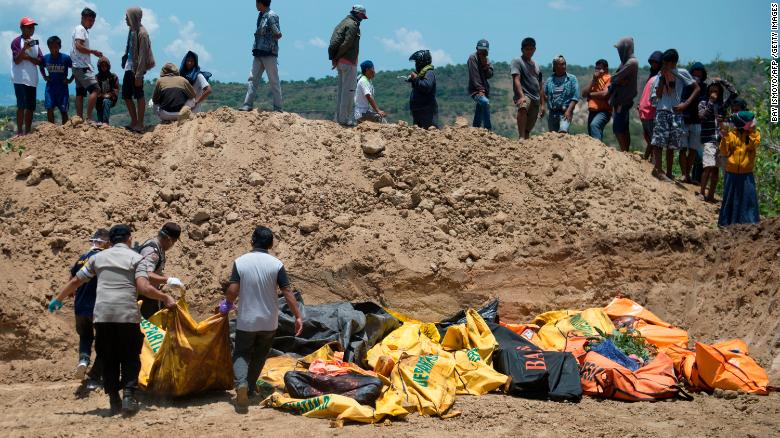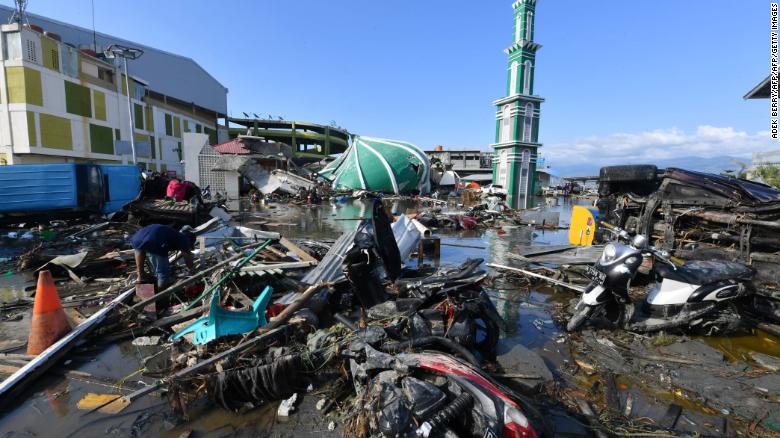Unfathomable Disaster, Palu, Indonesia
 |
| Body bags lie in an open ditch in Palu, Indonesia |
"I could see my father still embracing my sister. I just cried. I was able to save other people, but I was unable to save my own family."
"The ground I stepped on cracked -- water and mud came out, more and more from all directions."
"I took a two-year-old [child] on my head, a three-year-old on my back, and held a five-year-old while struggling to swim out from mud to the asphalt road."
Edi Setiwan, 32, Palu, Indonesia
"Up to Saturday, we still saw many people screaming for help from the roofs."
"But we could not do [anything] to help them."
"Now, their cries are no longer heard."
Idrus, 52, Palu, Indonesia
 |
| Still from Video -- Rescuers in Palu, Indonesia |
"There are still hundreds of victims buried in mud" in the area, noted disaster agency spokesman Sutopo Purwo Nugroho of the hardest hit area in the wake of a 7.5 earthquake that hit on Friday triggering a humanitarian crisis when a deadly tsunami of over three metres in height hit the exposed coastline around Palu on that fateful day. Over 1,200 people have so far been counted among the dead, a still-preliminary count where many others remain trapped under buildings that collapsed, difficult to get to because of the destroyed terrain.
Most casualties were quake-caused, and the result of the tsunami, but hundreds of people were trapped, crushed and killed by collapsing buildings; homes and hotels and shopping malls. Others were buried alive by the ground that underwent a liquefaction process when seawater washed ashore inundating unstable ground causing loose soil at the surface to collapse, the end result resembling a swamp of quicksand, where would-be rescuers desperately attempted to pull people out of the muck, saving some, but counting others among the dead, drowned in brown sludge.
Rescue teams evacuated people trapped under a 50-room, eight-storey hotel the earthquake had collapsed. Some were alive, while rescuers listened to the screams of others buried deep in the ruins through that long night, unable to reach and rescue them, the lights of their cellphones shining beneath the rubble. Three other hotels in Palu city also collapsed, their guests caught in the destroyed remnants of the hotels. It wasn't until Monday that rescue teams attempted the daunting, huge job of attempting to dig them out, no longer alive.

Sulawesi Island's Palu with its 380,000 residents was in ruins with toppled cellphone towers making communications in failure mode and electricity absent from downed power lines, plunging the ruined city in darkness. Countless residents are now in desperate need of food, water, fuel, medical attention and shelter. Thousands of panicked women and children have swarmed the city airport tarmac hoping to board military aircraft arriving with aid as authorities began burying bodies side-by-side in a mass grave, hoping to avoid a mass disease outbreak.
Edi Setiwan described seeing and feeling the neighbourhood he lived in sinking. He had attempted, after delivering his wife and year-old daughter to safety, to reach his parents' home roughly 300 metres away but he was met with a sea of mud. Along with other villagers, rescue efforts began, to save whoever could be saved, as ropes were thrown to people in pools of thick mud to pull them to safety. It was only the next day, Saturday, that he was able to reach the area where his parents lived.
His mother had been saved, but he discovered the bodies of his father and sister in the dark sludge.
 |
Indonesian rescuers work on the collapsed Roa Roa hotel as they
try to find survivors in Palu, central Sulawesi, Indonesia, 01 October
2018. EPA/MAST IRHAM
|
Labels: Disaster, Earthquake, Indonesia, Natural Disasters, Tsunami

<< Home